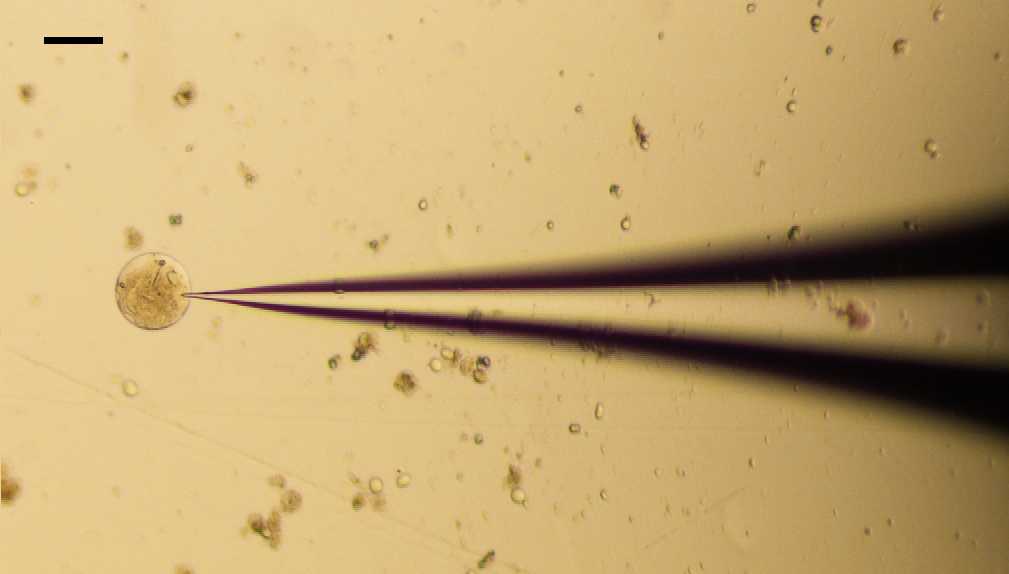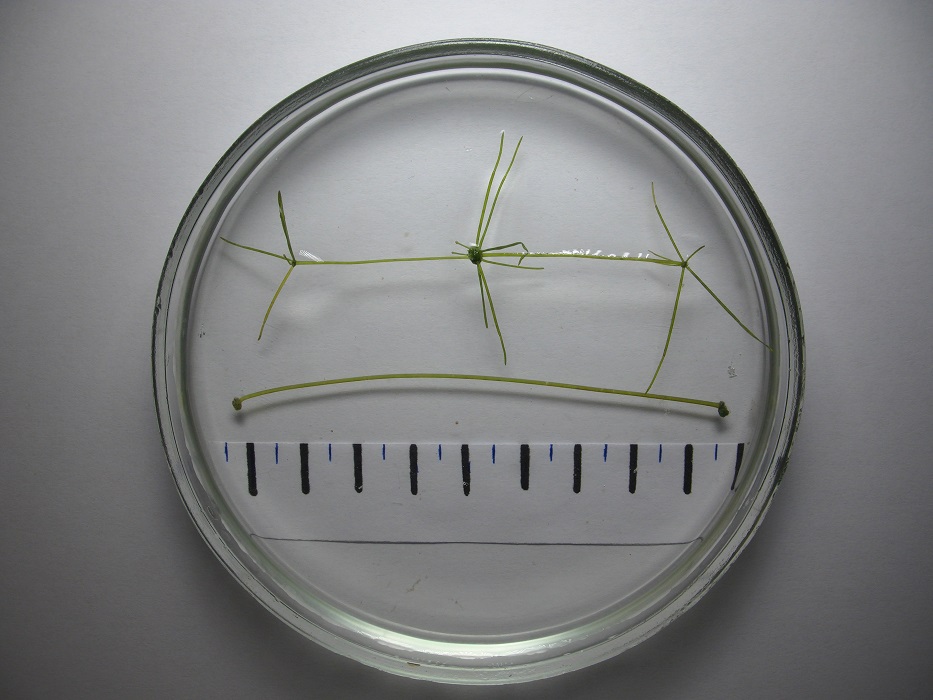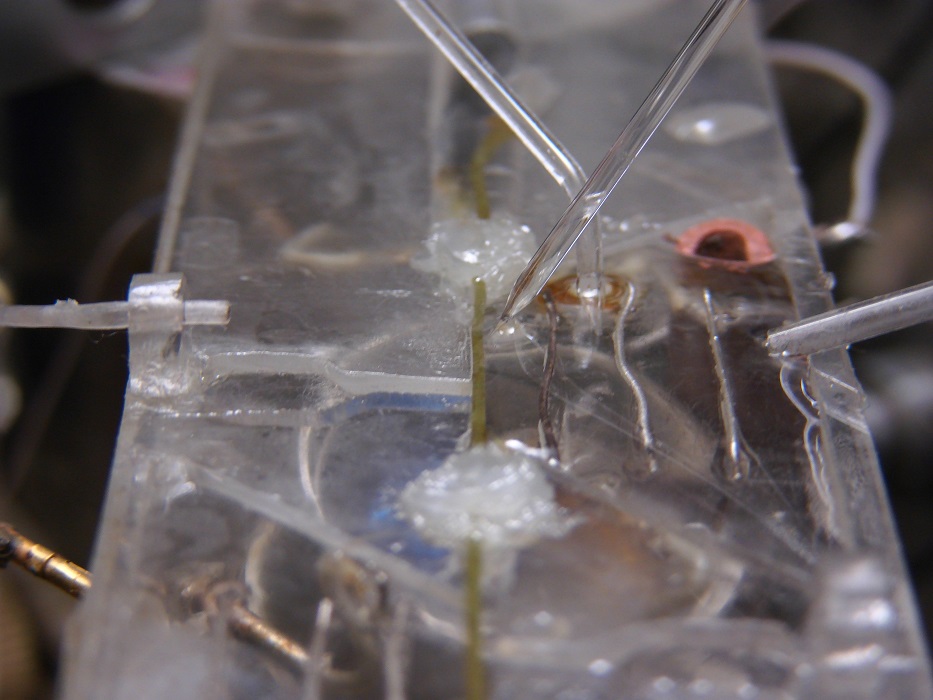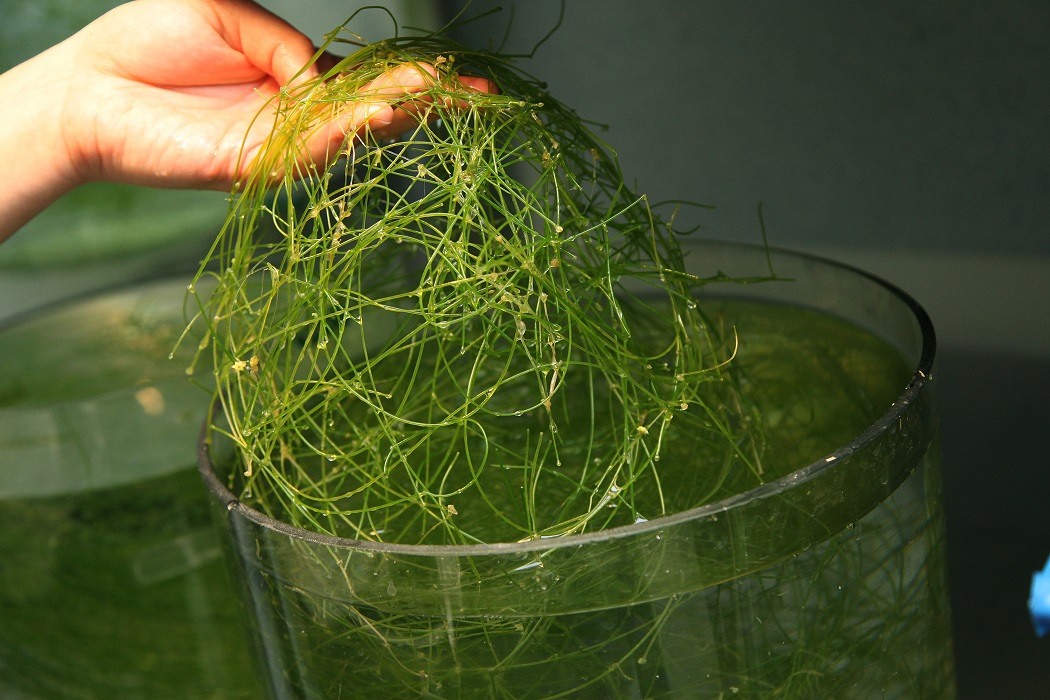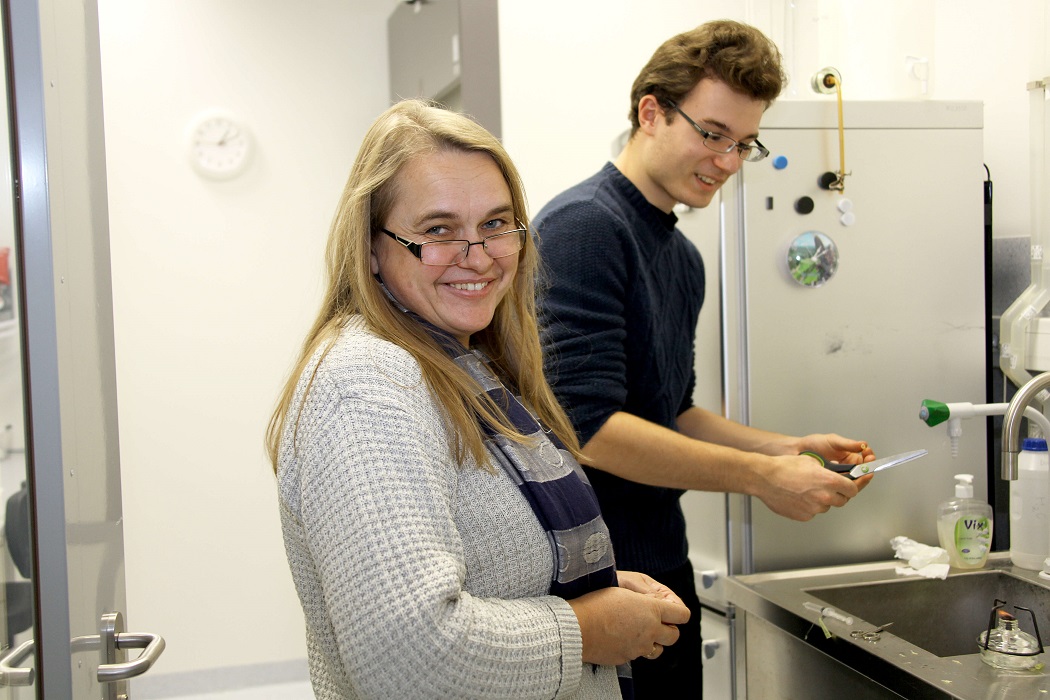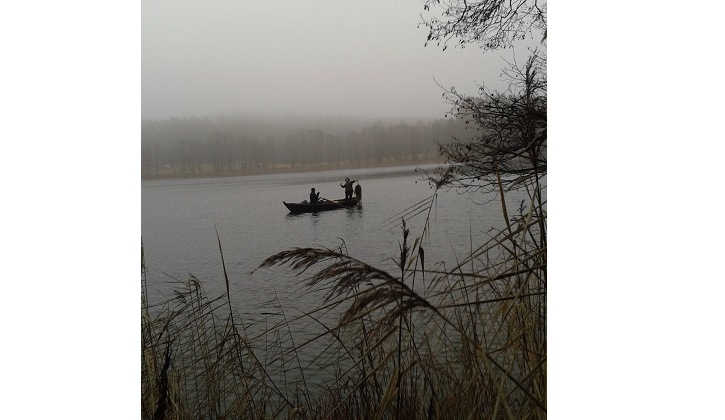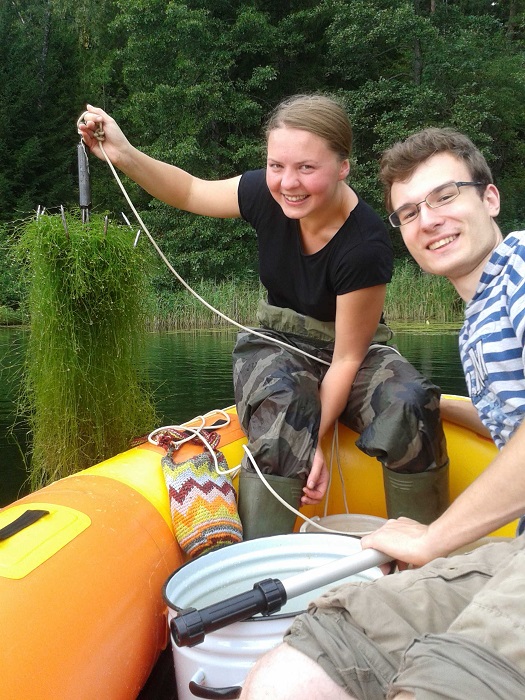The laboratory specializes in research of electrical properties of a unique plant model system – Characeaen cell. It’s widely used for electrophysiological research on a cell level because of its specific structure and physiology: Characean cells are large in size, structurally differentiated, physiologically stable, easily cultivated and most important has ability to generate action potentials in response to various stimuli and can be widely explored in plant excitability investigations.
Electrophysiological research in the Department of Biochemistry and Biophysics started in 1972. Data about the dynamics of the ion transport through the cell membrane and its dependence on various exogenic and endogenic factors has been collected. Combined and complex electrophysiological methods are used for the recoding of electrophysiological parameters by extracellular and intracellular glass-microelectrode techniques in voltage clamp, current clamp and patch clamp modes.
The effect of neurochemical compounds and various stress factors – temperature, ionizing radiation, heavy metals, - on generation of bioelectrical potentials and ion currents on the cell and single channel level, is investigated as well as the alterations of photoelectrical reaction when monochromatic light is applied.
The laboratory has been using universal computer I/O and data acquisition system (Voltage/Current Clamp amplifiers TEC-10CX or MultiClamp 700B, Digitizer Digidata 1440A or Digidata 2400 , A/D board controlled by software pCLAMP 10.2), micromanipulator MPC-385, software Clampex 10.2., preamplifier WPI DAM50, ADC ADS7805P.
Dr. Indrė Lapeikaitė defended the doctoral dissertation "Effect of amino acids and NMDA on electrical signalling parameters of Charophyte Nitellopsis obtusa" in the area of natural sciences, reasearch field of Biophysics (N 011).
Group members
Dr. Vilma Kisnieriene
Dr. Indre Lapeikaite
PhD Student Vilmantas Pupkis
Group members
Contacts
852398232, +370868370724
This email address is being protected from spambots. You need JavaScript enabled to view it.,
This email address is being protected from spambots. You need JavaScript enabled to view it.
Collaborators
- Department of Physiology and Biochemistry of Plants, Faculty of Biology, Belarusian State University, Minsk, Belarus
- Department of Biology, Kobe University, Japan
- Department of Life Science, Himachal Pradesh University, India,
Projects
2018-2022. Joint Lithuanian-Polish project “Long-distance electrical signalling systems in plants – adaptation to the change from water to terrestrial environment” (S-LL-18-1) (DAINA). Project leader - Dr. Vilma Kisnierienė
2017-2018. Project leader - Dr. Vilma Kisnierienė. Student: Pupkis V. „Blokatorių poveikio menturdumblio Nitellopsis obtusa tonoplasto joninių kanalų aktyvumui tyrimas „patch clamp“ metodu“, 09.3.3-LMT-K-712-03-0008.
2013-2014. Kisnieriene V. Investigation of basic electrical characteristics and ion channel activity of plant membranes. Matsumae International Foundation, Japan.
Sakalauskas V.EUROPEAN COMMISSION, LEONARDO DA VINCI PROGRAMME Pilot project, “Computerised Laboratory in Science and Technology Teaching”, Agreement number: SI 143008, Contracting period: 01.12.2000 – 28.02.2004, Contractor: University of Ljubljana, Faculty of Education.
LEONARDO DA VINCI 2 PROGRAMME, project ComLab2 (“Computerised Laboratory in Science and Technology Teaching -2”), Project number SI-05-B-F-PP-176008, Contracting period: 01.12.2005 – 31.12.2007, Contractor: University of Ljubljana, Faculty of Education.
Joint Lithuanian-Polish project “Long-distance electrical signalling systems in plants – adaptation to the change from water to terrestrial environment” (S-LL-18-1) (DAINA).
Publications
- Pupkis, V., Lapeikaite, I., Kavaliauskas, J., Trębacz, K., Kisnieriene, V. (2022). Certain calcium channel inhibitors exhibit a number of secondary effects on the physiological properties in Nitellopsis obtusa: a voltage clamp approach. Functional Plant Biology 50, pp. 195-205.
- Kisnieriene, V., Trębacz, K., Pupkis, V., Koselski, M., & Lapeikaite, I. (2022). Evolution of long-distance signalling upon plant terrestrialization: comparison of action potentials in Characean algae and liverworts. Annals of Botany. 130(4), pp. 457-475
- Koselski M., Pupkis V., Hashimoto K., Lapeikaite I., Hanaka A., Wasko P., Plukaite E., Kuchitsu K., Kisnieriene V. Trebacz, K. (2021). Impact of Mammalian Two-Pore Channel Inhibitors on Long-Distance Electrical Signals in the Characean Macroalga Nitellopsis obtusa and the Early Terrestrial Liverwort Marchantia polymorpha. Plants, 10(4), 647.
- Lapeikaite I, Pupkis V, Neniskis V, Ruksenas O, Kisnieriene V (2020) Glutamate and NMDA affect cell excitability and Action Potential dynamics of single cell of macrophyte Nitellopsis obtusa. Funct. Plant Biol https://doi.org/10.1071/FP20074.
- Pupkis V, Lapeikaite I, Kisnieriene V. Electrophysiological Examination of the Effects of Classical Pharmacological Agent Verapamil in Plant-Based Model System. 64th Annual meeting of the Biophysical Society, 2020, San Diego (USA), Biophysical Journal 118 (3 Supplement 1), p. 591A.
- Kisnieriene V, Pupkis V, Lapeikaite I. Exploring electrical signalling alterations of Nitellopsis obtusa cells in response to modulators of ion channels. Joint 12th EBSA congress and 10th ICBP – IUPAP congress, 2019, Madrid (Spain), European Biophysics Journal with Biophysics Letters 48 (1 Supplement), p. S162.
- Lapeikaite I, Dragunaite U, Pupkis V, Ruksenas O, Kisnieriene V (2019) Asparagine alters action potential parameters in single plant cell. Protoplasma 256, 511–519
- Kisnieriene V, Lapeikaite I, Pupkis V, Beilby MJ (2019) Modeling the Action Potential in Characeae Nitellopsis obtusa: Effect of Saline Stress. Frontiers in Plant Science, 10, 1–15.
- Kisnieriene V, Lapeikaite I, Pupkis V (2018) Electrical signalling in Nitellopsis obtusa: Potential biomarkers of biologically active compounds. Funct. Plant Biol. 45(2), 132-142.
- Kisnieriene, V., Lapeikaite, I. and Pupkis, V. (2018). Neurotransmitters in Characeaen Electrical Signaling in Ramakrishna, A. and Roshchina, V.V. (eds.). Neurotransmitters in Plants: Perspectives and Applications, CRC Press; pp. 181-200.
- Vilma Kisnieriene, Indre Lapeikaite, Olga Sevriukova, Osvaldas Ruksenas. The effects of Ni2+ on electrical signaling of Nitellopsis obtusa cells. Journal of Plant Research, 2016, DOI 10.1007/s10265-016-0794-3.
- Vilma Kisnierienė, Indrė Lapeikaitė. When chemistry meets biology: the case of aluminium – a review. Chemija, 2015, 26 (3), p. 148–158.
- Vilma Kisnierienė, Jonas Burneika, Indrė Lapeikaitė, Olga Sevriukova, Algis Daktariūnas. Investigation of membrane potential changes in Nitellopsis obtusa cells induced by blue and red light stimulation. Biologija, 2014. Vol. 60. No. 2. p. 71–78.
- Olga Sevriukova, Auste Kanapeckaite, Vilma Kisnieriene, Rima Ladygiene, Indre Lapeikaite, and Vidmantas Sakalauskas. Modifying action of tritium on the charophytes bioelectrical response to anthropogenic pollution. Trace Elements and Electrolytes. 2014, 31 (2), p. 60-66.
- Olga Sevriukova, Auste Kanapeckaite, Indre Lapeikaite, Vilma Kisnieriene, Rima Ladygiene, Vidmantas Sakalauskas. Charophyte Electrogenesis as a Biomarker for Assessing the Risk from Low-Dose Ionizing Radiation to a Single Plant Cell. Journal of Environmental Radioactivity. Journal of Environmental Radioactivity, 2014, 136, p. 10-15.
- Olga Sevriukova, Auste Kanapeckaite, Indre Lapeikaite, Vilma Kisnieriene, Vidmantas Sakalauskas. Impact of low dose Tritium on the bioelectrical activity of Charophyte cell. Proceedings of 11th International Conference on Medical Physics Kaunas University of Technology, 2013, p. 61-66.
- V. Kisnieriene, T. I. Ditchenko, A. P. Kudryashov, V. Sakalauskas, V. M. Yurin, O. Ruksenas. The effect of acetylcholine on Characeae K+ channels at rest and during action potential generation. Central European Journal of Biology, 2012 Vol. 7, No. 6, p. 1066-1075.
- V. Kisnierienė, V. Sakalauskas, A. Pleskačiauskas,V. Yurin, O. Rukšėnas:The combined effect of Cd2+ and ACh on action potentials of Nitellopsis obtusa cells, Central European Journal of Biology, 2009 Vol. 4, No. 3, p. 343-350.
- V. Kisnierienė, K. Beitas, V. Sakalauskas, A. Daktariūnas: Information technologies for biology education: computerized electrophysiology of plant cells, Informatics in education, 2008, Vol.7, No.1, p. 91-104.
- V.Kisnieriene, V. Sakalauskas: The effect of aluminium on bioelectrical activity of the Nitellopsis obtusa cell membrane after H+-ATPase inhibition, Central European Journal of Biology, 2007, Vol.2, No.2, p. 222-232.
- V. Kisnieriene, V. Sakalauskas: “Al3+ indused membrane potential changes in Nitellopsis obtusa cells”, Biologija,Vol 1, 2005, p. 31-34.
